We launched SPI Pro in July, but our team had been dreaming about it for over a year. Recently, I talked with SPI’s co-CEOs, Matt and Pat, about the story of SPI Pro, and why and how we started this membership community. If you’re thinking of starting your own membership community, hopefully this will give you inspiration and a way forward.
Step 1: Recognize the Problem
At the end of 2018, Matt and Pat were concerned.
It was right before they merge their two companies (Matt and his team at Winning Edits, a creative agency, merged with Smart Passive Income ), and as they discussed the future of the company, they recognized a problem.
Online course sales had been the main revenue for SPI for a few years by then.
“We were having conversations about the future of online courses,” says Matt.“We had been tracking the financial performance on SPI course sales for at least a year at that point. So I was thinking about the business model in the future and in the context of the industry and I realized, Okay, we’re struggling with certain promotions.”
SPI was doing a lot of the same things we had been doing for years, creating courses, and then promoting them. Course promotions and sales were happening a few times a quarter and were labor-intensive and time-consuming.
“Some of our tactics were still working, but it was too risky to just be dependent on one primary revenue stream,” says Matt.
Instead, he wanted to create a business model with more stability and predictability. “I felt strongly we needed to grow and diversify across some new offerings, and add some new dimensionality into the business model,” he says.
Recurring Revenue? Tell Me More
In all of its twelve years of existence, SPI had never had a recurring revenue component. “Inherently in any business where you’re just doing sales all the time, there’s a more volatile top line,” says Matt.
The other problem with course sales is that creating and promoting them takes a lot of the team’s time and energy. “We didn’t want course revenue to be the main thing forever. I’m not suggesting that I was worried that course revenue was going to decline to zero or that there was going to be some kind of bubble that bursts in terms of the market popping and people just all of a sudden not buying courses. I don’t think that’s true, especially not this year when everyone’s more than ever going online for education. But it’s an inherent, existential threat to this business—or would be any business—if you’re just relying on one primary source of revenue.”
Matt asked Pat if he was open minded to trying to diversify some things. Pat said he would love recurring revenue as a broader concept.
Okay, cool.
Step 2: Develop the Idea
“So what Pat and I were talking about at that point was more like, ‘Oh, what if, what if it was more like a digital conference or a digital gathering,’ with that frame of mind,” Matt says.
“Entrepreneurship is a very lonely path,” says Pat, “especially when you’re just starting out and you feel like there’s nobody else in the world who can understand you, and it’s why people show up at conferences. It’s why people are in Facebook groups.”
In-Person Inspiration—How FlynnCon Showed the Way
Pat’s theory was confirmed at FlynnCon, SPI’s first in-person conference, which happened in July 2019.
“There was a certain magic at FlynnCon that we wanted to try to replicate in a certain way digitally, online.” Pat says. “Time and time again, I hear feedback about FlynnCon, and it was the moments in between the main sessions. It was those talks in the hallways. It was the connections. It was just the mastermind groups that were created in those moments that really provided the true value there.”
Around this time, Matt drew the vision for what, at the time, he and Pat were calling SPI Plus (which would later become SPI Pro).
Having a place where people find each other and get support from each other, and from Pat and the SPI team, was the vision that started to emerge.
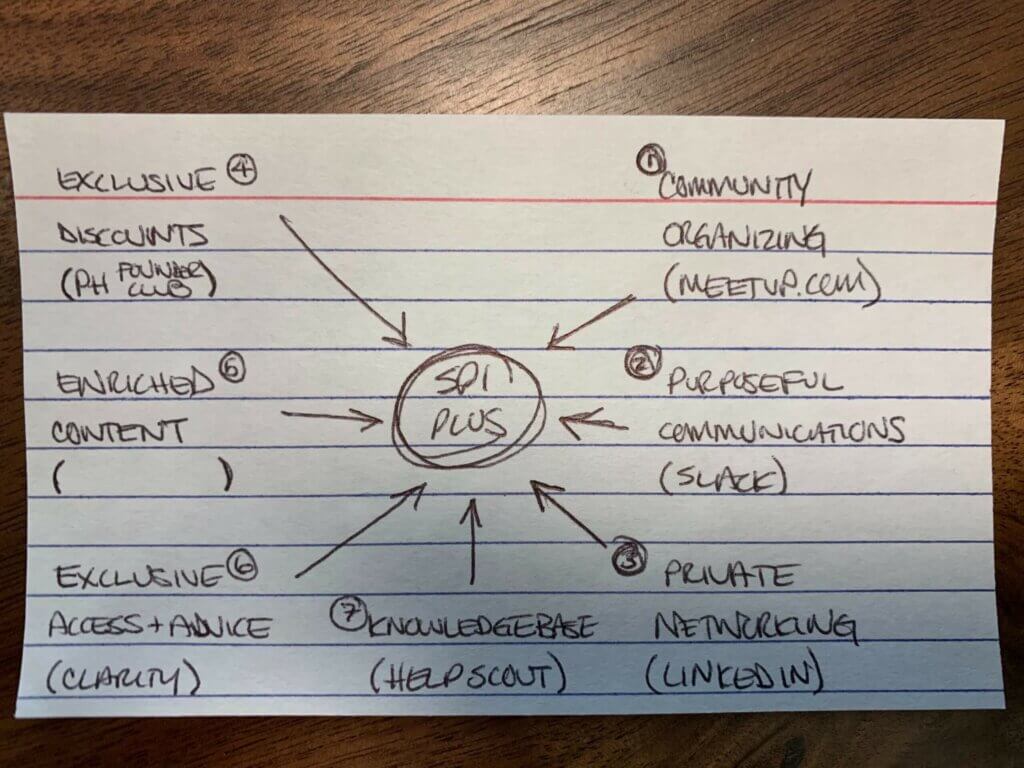
Matt’s original notecard vision for what SPI Plus (later SPI Pro) could become.
“So it was at the time called SPI Plus in my mind. So you see SPI Plus in the center of the card, not SPI Pro. And it was this six-dimensional, a composite idea of community as represented in the digital sense by Meetup.com.”
Components of the Community Idea
Matt’s idea had six components. The program needed to have:
- Community
- Purposeful communications (similar to Slack)
- The ability to have private networking (similar to LinkedIn)
- A robust knowledge base (similar to HelpScout)
- Exclusive access and advice (Clarity)
- Enriched content created specifically for the needs of the community
- Exclusive discounts
Step 3: Pivot When Necessary
The conversations continued—between Matt and Pat, and eventually the rest of the SPI Team—around the idea of SPI Pro.
During our annual team retreat in Columbus, Ohio in the fall of 2019, SPI Pro was pegged as one of the “big new things” we would launch in 2020.
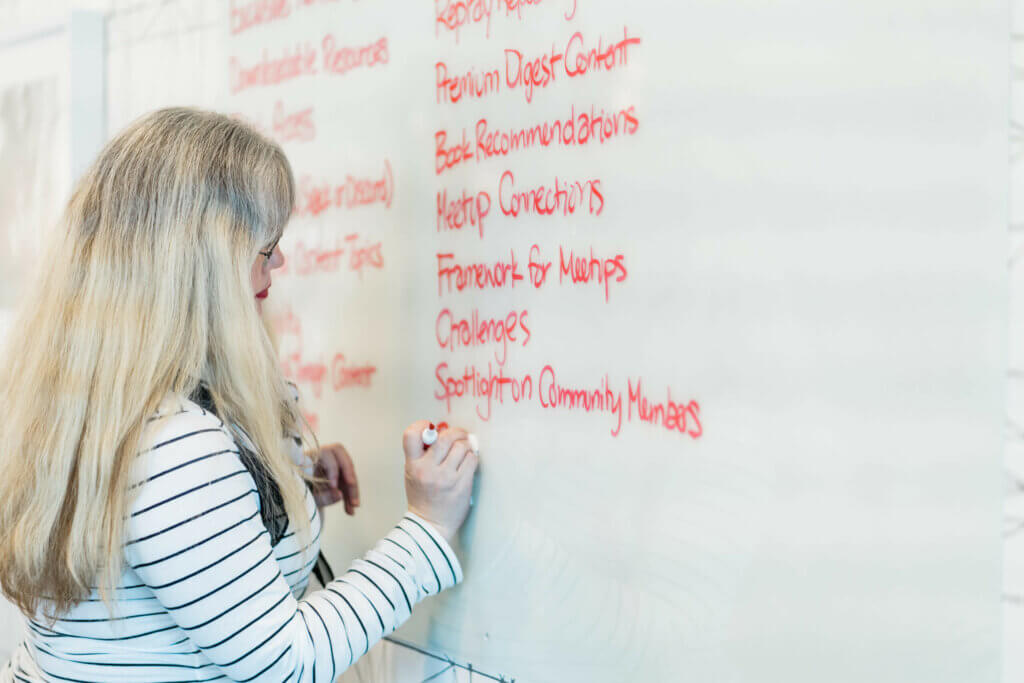
“Our idea was to be on stage, like at an Apple event when they roll out their big, new thing. We wanted to get some hoopla and fanfare and try to do some, you know, new member enrollments right from the conference,” says Matt.
But then COVID happened.
We had to cancel FlynnCon.
Our dreams of rolling it out with a lot of hoopla on stage at FlynnCon were dead.
From Disappointment to Opportunity and Urgency
“We were like, okay, we’re not launching from stage anymore. How are we going to launch this instead?” says Matt.
Besides having to pivot our launch plans for SPI Pro when FlynnCon was canceled, we felt even more of an urgency to get SPI Pro up and running.
People were in quarantine. Everyone was working from home, isolated. We knew that a membership community would be one way people could connect online since no one could go to in-person meetups or conferences.
The sad reality of having to cancel FlynnCon came with a silver lining: It gave the SPI Team more time to focus on getting SPI Pro ready to go.
Step 4: Pick a Platform
During this whole time, Matt was evaluating what kind of platform would support our vision for the membership community.
Where would we host it? His original idea for the community was inspired by various tech platforms (Slack, Meetup, LinkedIn), but was there something out there that combined all of those things into one platform?
“I was evaluating different platforms like Mighty Networks and Podia. I was walking through the software, getting a feel for, Is this going to support the vision and the concept that I have?” Matt says.
He was also in contact with Ankur Nagpal, the founder and CEO of Teachable. Teachable has housed the SPI courses from day one, and since we knew much of the SPI community consists of people who have taken SPI courses, Matt was keeping Ankur up to date on his thinking around SPI Pro, getting his inputs about various platforms, and even wondering if Teachable would eventually be creating something that we could use.
Circling Down to the Best Option
But then Ankur was like, ‘“Holy s**t, you should talk to the Circle guys—they are some former top brass Teachable employees who would just love to do this thing.”
The three founders of Circle.so, Sid Yadav, Andrew Guttormsen, and Rudy Santino, had all worked at Teachable and left to create their own platform specifically for creators to develop their own membership communities.
“So we talked to them, and we were very impressed at their functional prototype at that point,” says Matt. “We set up a meeting in February. I went to New York, and when I was there in person, they had certainly advanced on their prototype. I saw more. And basically I made the decision there that this was what we were going to do. I called Pat a couple of times to keep him in the loop. And I told him, ‘Yeah, this is it. We’ve got to say yes to this, we’ve got to do this.’”
Check out our in-depth interview with Circle founder Sid Yadav
Pat was totally on board. Circle’s vision is for creators to architect a membership community the way that they want it to be, versus being forced into a one-size-fits-all way of thinking about community.
“We’d been doing a lot of research on these platforms, and Circle seemed to be the best fit for us in the way that we wanted this and the experience we want people to have within the community in SPI Pro,” says Pat. “We definitely have fallen in love with the Circle platform. It takes all the best things about Facebook groups and combines them with the best things about Slack.”
Step 5: Build the Product
So we had the idea. We had the platform. Now we just had to build SPI Pro.
In March of this year, Matt laid out his vision to the whole team at SPI and started delegating projects and tasks. It was all hands on deck.
Putting Together All the Pieces
The whole team dove into the implementation phase, including developing and implementing plans for:
- The SPI Pro membership application
- Billing set-up
- Onboarding plans for new members
- Rules and policy documentation
- A schedule of events and meetups
- Creating content, including eight ebooks
- Deals and discounts
- Integration with our other platforms
We also had to figure out what features would provide value but not be overwhelming for members. After several iterations of what we wanted to include in the membership community, we settled on a set of features, events, and content that we felt would offer our community real value and give them what they needed.
“Our ideas for what to include were rooted in an ethos of connection more than content and connection even before engagement,” says Matt. “I give my friend Jay Clouse credit for that connection-before-engagement concept. Jay is a great guy. He’s one of the consultants we’ve brought on to advise on some of the finer points as we develop SPI Pro, which is we want our members to establish their own connections, to discover people, to find their own buddy programs to develop little mastermind groups that might even live, and they can actually have their conversations in private channels within SPI Pro.”
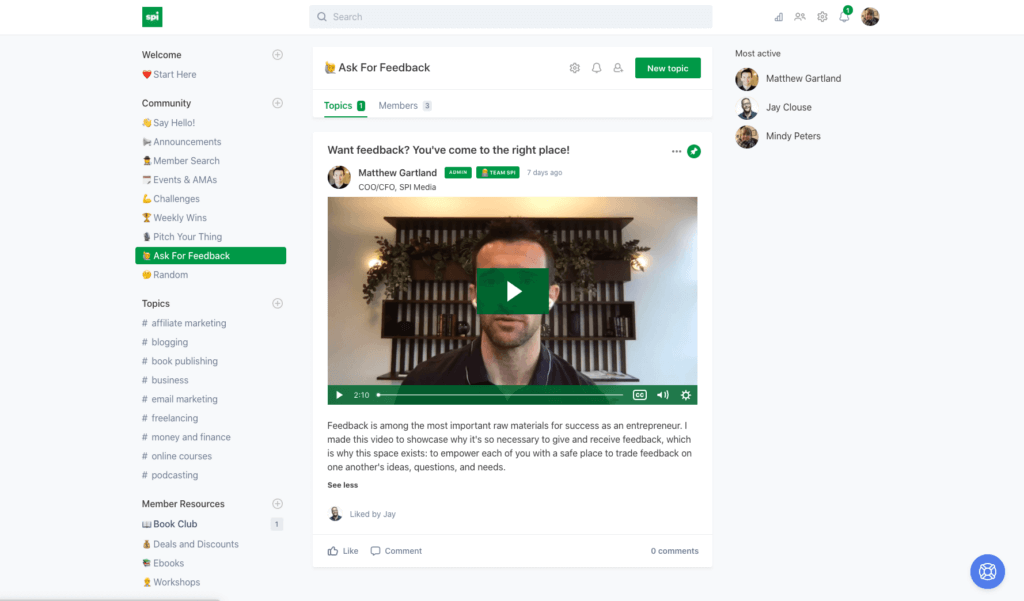
SPI Pro Features
The features we landed on include:
- Learning channels for discussions around skill development topics such as podcasting, affiliate marketing, and email marketing
- Discovery channels for member networking, collaborations, and more
- Monthly challenges that encourage, support, and reward member growth
- Pitch opportunities where members can get exposure for their new thing
- Private channels for focused discussions among member cohorts
- Private 1:1 messaging between community members
- Matchmaking with a mastermind group or accountability partner
- A monthly book club discussion
- Free workshops and “ask an expert” events
- Free content such as ebooks
- New members community hangouts
- Regular ask me anything (AMA) events hosted by Pat and SPI team members
- Professional networking community hangouts organized around themes
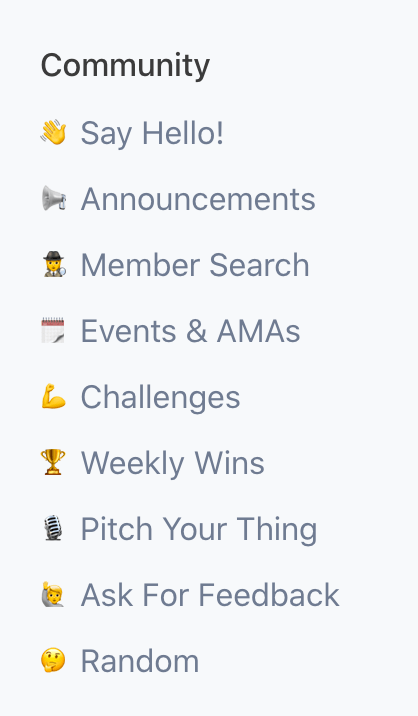
“We consolidated pretty dramatically the first version of our information architecture for the community,” says Matt. “We ended up with a sharper focus, less overwhelm, more intentional messaging, especially for new members when you come in. You have to think about the experience that a person has, not just what is typical in a lot of other membership site platforms, which is just, ‘Let’s dump everything in there and just have them pay monthly to get access to everything.’ That’s not the most helpful thing.”
The features and value within SPI Pro is what keeps members coming back. We had to think about what’s the motivation to consider logging into SPI Pro every day.
Step 6: Launch the Community & Celebrate!
Finally, in July we were ready to welcome people into the community.
We couldn’t launch SPI Pro at FlynnCon as The Next Big Thing. But we still promoted it on the SPI Podcast, in the Smart Digest newsletter, and through an email campaign and social media.
The launch has been a huge success. We have over 500 members (exceeding our goal), with new people applying to join each day.
Members are networking, learning, creating mastermind groups, connecting one-on-one, asking questions, getting feedback on ideas, and much more.
It’s already a thriving community, and we couldn’t be more excited.
Recently, we hired a community manager, Jillian Benbow, and have plans to go bigger next year in terms of marketing and try to get some extra firepower behind it.
“It takes community,” says Pat. “It takes commitment. It takes accountability and getting involved with a group of people who speak, and talk, and think just like you. There’s nothing better than that. We can be all of our weird entrepreneurial selves in SPI Pro, when oftentimes we can’t have conversations with our immediate family about these things because they just don’t understand.”
“That’s what we’re building here. I just haven’t been so excited about a project in so long. I mean, I get excited about every project, but nothing to this level.”
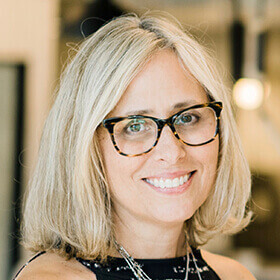 Karen Beattie
Karen Beattie
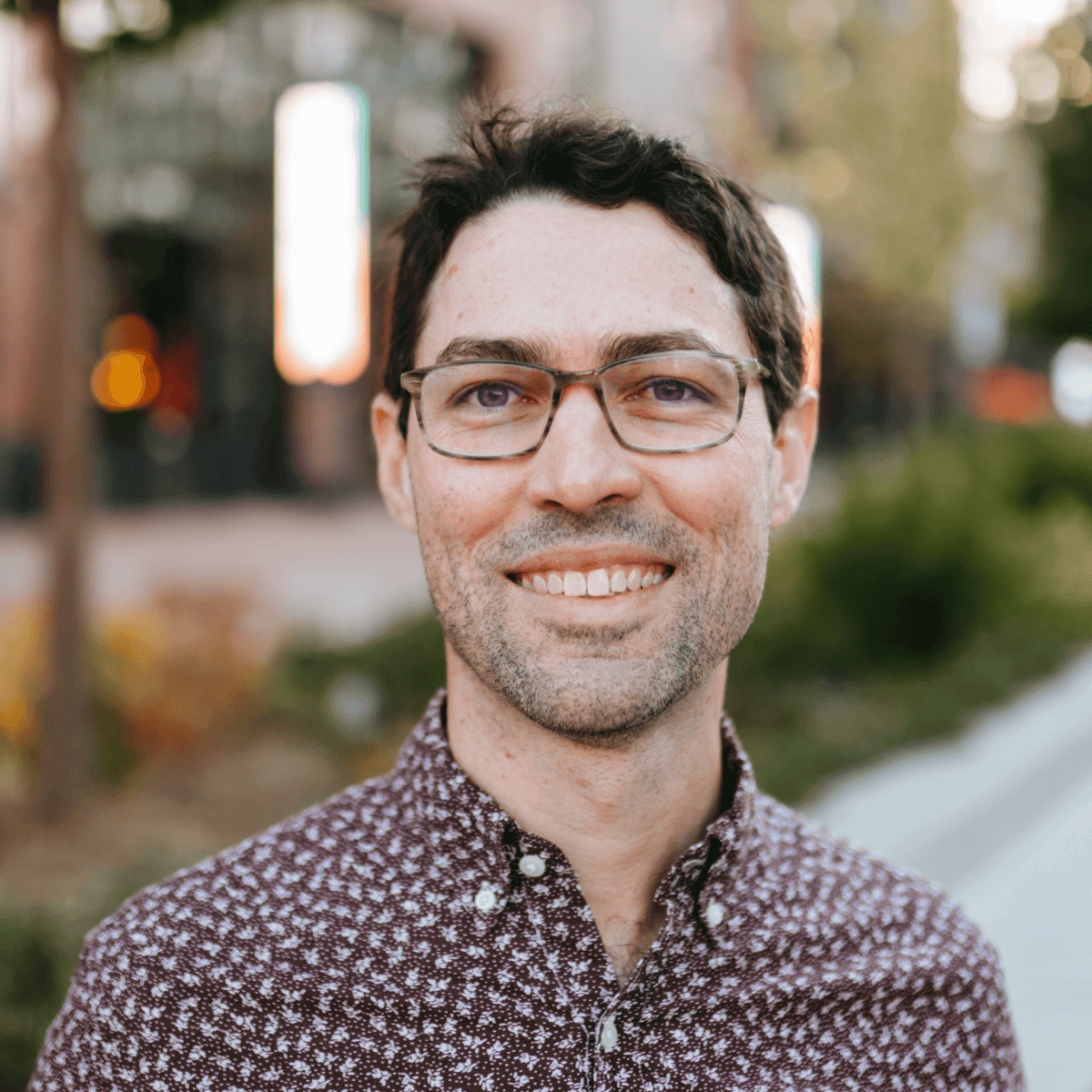 Ray Sylvester
Ray Sylvester

